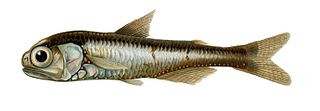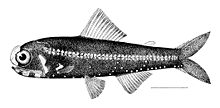
Lanternfish are small mesopelagic fish of the large family Myctophidae. One of two families in the order Myctophiformes, the Myctophidae are represented by 246 species in 33 genera, and are found in oceans worldwide. Lanternfishes are aptly named after their conspicuous use of bioluminescence. Their sister family, the Neoscopelidae, are much fewer in number but superficially very similar; at least one neoscopelid shares the common name "lanternfish": the large-scaled lantern fish, Neoscopelus macrolepidotus.

Hector's lanternfish is a lanternfish in the family Myctophidae, the only species in the genus Lampanyctodes. It is named after James Hector.

Diaphus is a genus of lanternfishes. It is the most species-rich lanternfish genus.

Electrona risso is a species of myctophiform ray-finned fish in the family Myctophidae, the lanternfishes. It is known commonly as the electric lantern fish, chubby flashlight fish, and Risso's lantern-fish. It is a widespread species of all the oceans.
Diaphus danae, the Dana lanternfish, is a species of lanternfish found in the Atlantic and Indian Oceans.
Diaphus diadematus, the crown lanternfish, is a species of lanternfish found worldwide.
Diaphus jenseni, the Jensen's lanternfish, is a species of lanternfish found in the Indo-Pacific, the Southeast Atlantic Ocean and there South China Sea.
Diaphus mollis, the soft lanternfish, is a species of lanternfish found in the Atlantic and Indian Oceans.
Diaphus regani, the Regan's lanternfish, is a species of lanternfish found in the Atlantic and Indian Oceans.
Diaphus burtoni is a species of lanternfish found in the Philippines and the Western Central Pacific Ocean.
Diaphus whitleyi, is a species of lanternfish found in the Philippines and the Western Central Pacific Ocean.
Diaphus lucifrons is a species of lanternfish found in the Philippines and the Western Central Pacific Ocean.
Diaphus subtilis is a species of lanternfish found in the Atlantic Ocean.
Diaphus meadi, Mead's lanternfish, is a species of lanternfish found pretty much worldwide.
Diaphus impostor, the imposter lanternfish, is a species of lanternfish found in the Western Central Pacific Ocean.
Diaphus vanhoeffeni, is a species of lanternfish found in the Eastern Atlantic Ocean.
Diaphus dumerilii, Dumeril's lanternfish, is a species of lanternfish found in the Eastern Atlantic Ocean.
Diaphus taaningi, the Slopewater lanternfish, is a species of lanternfish found in the Eastern Atlantic Ocean.
Diaphus lucidus, the spotlight lanternfish, is a species of lanternfish found worldwide.
Diaphus problematicus, the problematic lanternfish, is a species of lanternfish found worldwide.





